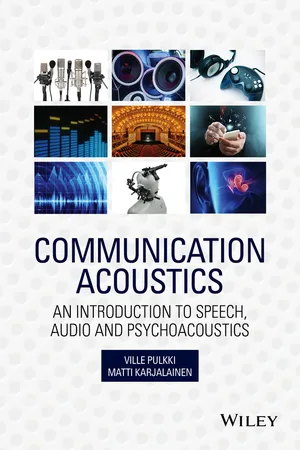
Communication Acoustics
An Introduction to Speech, Audio and Psychoacoustics
- English
- ePUB (mobile friendly)
- Available on iOS & Android
Communication Acoustics
An Introduction to Speech, Audio and Psychoacoustics
About This Book
In communication acoustics, the communication channel consists of a sound source, a channel (acoustic and/or electric) and finally the receiver: the human auditory system, a complex and intricate system that shapes the way sound is heard. Thus, when developing techniques in communication acoustics, such as in speech, audio and aided hearing, it is important to understand the time–frequency–space resolution of hearing.
This book facilitates the reader's understanding and development of speech and audio techniques based on our knowledge of the auditory perceptual mechanisms by introducing the physical, signal-processing and psychophysical background to communication acoustics. It then provides a detailed explanation of sound technologies where a human listener is involved, including audio and speech techniques, sound quality measurement, hearing aids and audiology.
Key features:
- Explains perceptually-based audio: the authors take a detailed but accessible engineering perspective on sound and hearing with a focus on the human place in the audio communications signal chain, from psychoacoustics and audiology to optimizing digital signal processing for human listening.
- Presents a wide overview of speech, from the human production of speech sounds and basics of phonetics to major speech technologies, recognition and synthesis of speech and methods for speech quality evaluation.
- Includes MATLAB examples that serve as an excellent basis for the reader's own investigations into communication acoustics interaction schemes which intuitively combine touch, vision and voice for lifelike interactions.
Frequently asked questions
Information
1
How to Study and Develop Communication Acoustics
1.1 Domains of Knowledge
- Acoustics and the fundamentals of physical sound deal with the interaction between physical objects that form the basis for sound and vibration phenomena. This domain answers questions on how sound is generated by sound sources, how it propagates or is absorbed, how it behaves in a closed space such as a room, auditorium, or a concert hall, and so on.
- Signal processing comprises the theories and techniques on how signals carrying information are generated, transmitted, analysed, or transformed by humans, in nature, or using technical devices. In this domain, the basic physical details are of less importance, and abstraction from physical interaction to (typically) one-directional input–output causal relations is emphasized.
- Speech and audio are concerned with the fundamental characteristics of spoken and audio signals, and the specific techniques for communication with them. Spoken language and speech or language technology are of great importance, although in this book we will discuss them only briefly. Music, music acoustics, and music technology also belong to this category.
- Physiology and the psychophysics (psychoacoustics) of hearing study how our auditory system works both from a physiological and a functional point of view. This domain includes several important subtopics, one of which is spatial hearing, which deals with how we localize sound sources and perceive sound environments.
- Mathematics and computer science are the sciences that provide the general methodologies required to get the formal understanding necessary to model and realize complex communication processes.
- Engineering applications is the field that utilizes a wide variety of techniques for sound and voice communications. This includes traditional acoustics design, control of noise, speech technology (speech analysis, synthesis, coding, recognition), audio technology (recording, production, reproduction), multimedia sound (integration of sound with other modalities) virtual acoustics, and technical audiology for helping with hearing problems, etc.
1.2 Methodology of Research and Development
- Experimentation with, say, concrete physical or psychophysical, systems. This has been the standard approach used by scientists and engineers, augmented by practical or theoretical thinking. Concrete experimentation involves a large number of details, which makes seeing general laws behind the multitude of phenomena difficult, but on the other hand it helps to verify that the thinking is not too far from reality.
- Modelling of an object or phenomenon by means of constructing another kind of system that simulates the original phenomenon or object but is easier to experiment with. The first modelling techniques were based on constructing concrete, physical objects as models. The modern approach, using computer-based simulation, has expanded the capability of modelling techniques dramatically.
- Theory formation is a conceptual approach to formulating general principles inherent in a specific field of research. A theory has higher generality and potentially the widest applicability compared to experimentation and modelling techniques. On the other hand, very general theories are hard to apply to complex and specific cases in practice; they rather help and direct the thinking process.

1.3 Systems Approach to Modelling
Table of contents
- Cover
- Title page
- Copyright page
- Dedication page
- About the Authors
- Preface
- Preface to the Unfinished Manuscript of the Book
- Introduction
- 1 How to Study and Develop Communication Acoustics
- 2 Physics of Sound
- 3 Signal Processing and Signals
- 4 Electroacoustics and Responses of Audio Systems
- 5 Human Voice
- 6 Musical Instruments and Sound Synthesis
- 7 Physiology and Anatomy of Hearing
- 8 The Approach and Methodology of Psychoacoustics
- 9 Basic Function of Hearing
- 10 Basic Psychoacoustic Quantities
- 11 Further Analysis in Hearing
- 12 Spatial Hearing
- 13 Auditory Modelling
- 14 Sound Reproduction
- 15 Time–Frequency-domain Processing and Coding of Audio
- 16 Speech Technologies
- 17 Sound Quality
- 18 Other Audio Applications
- 19 Technical Audiology
- Index
- End User License Agreement